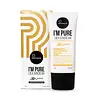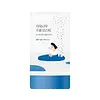What's inside
What's inside
 Key Ingredients
Key Ingredients

 Benefits
Benefits

 Concerns
Concerns

 Ingredients Side-by-side
Ingredients Side-by-side

Water
Skin ConditioningCyclopentasiloxane
EmollientZinc Oxide
Cosmetic ColorantCI 77891
Cosmetic ColorantPropanediol
SolventPolyglyceryl-3 Polydimethylsiloxyethyl Dimethicone
Skin ConditioningDibutyl Adipate
EmollientCaprylyl Methicone
Skin Conditioning1,2-Hexanediol
Skin ConditioningDisteardimonium Hectorite
StabilisingMagnesium Sulfate
Hydrogen Dimethicone
Aluminum Hydroxide
EmollientC30-45 Alkyl Cetearyl Dimethicone Crosspolymer
EmollientPolyglyceryl-2 Dipolyhydroxystearate
Skin ConditioningStyrene/Acrylates Copolymer
Stearic Acid
CleansingHelianthus Annuus Seed Oil
EmollientPentylene Glycol
Skin ConditioningButylene Glycol
HumectantEthylhexylglycerin
Skin ConditioningOctyldodecanol
EmollientCentella Asiatica Extract
CleansingGalactomyces Ferment Filtrate
HumectantAnthemis Nobilis Flower Oil
MaskingEchium Plantagineum Seed Oil
Skin ConditioningSalvia Hispanica Seed Extract
EmollientHouttuynia Cordata Extract
Skin ConditioningFructooligosaccharides
HumectantSaccharide Hydrolysate
HumectantPullulan
Cardiospermum Halicacabum Flower/Leaf/Vine Extract
Skin ConditioningHelianthus Annuus Seed Oil Unsaponifiables
EmollientMadecassoside
AntioxidantDicaprylyl Carbonate
EmollientSorbitan Sesquioleate
EmulsifyingCyclomethicone
EmollientUndecane
EmollientTridecane
PerfumingTocopherol
AntioxidantDimethicone Crosspolymer
Emulsion StabilisingPhenyl Trimethicone
Skin ConditioningWater, Cyclopentasiloxane, Zinc Oxide, CI 77891, Propanediol, Polyglyceryl-3 Polydimethylsiloxyethyl Dimethicone, Dibutyl Adipate, Caprylyl Methicone, 1,2-Hexanediol, Disteardimonium Hectorite, Magnesium Sulfate, Hydrogen Dimethicone, Aluminum Hydroxide, C30-45 Alkyl Cetearyl Dimethicone Crosspolymer, Polyglyceryl-2 Dipolyhydroxystearate, Styrene/Acrylates Copolymer, Stearic Acid, Helianthus Annuus Seed Oil, Pentylene Glycol, Butylene Glycol, Ethylhexylglycerin, Octyldodecanol, Centella Asiatica Extract, Galactomyces Ferment Filtrate, Anthemis Nobilis Flower Oil, Echium Plantagineum Seed Oil, Salvia Hispanica Seed Extract, Houttuynia Cordata Extract, Fructooligosaccharides, Saccharide Hydrolysate, Pullulan, Cardiospermum Halicacabum Flower/Leaf/Vine Extract, Helianthus Annuus Seed Oil Unsaponifiables, Madecassoside, Dicaprylyl Carbonate, Sorbitan Sesquioleate, Cyclomethicone, Undecane, Tridecane, Tocopherol, Dimethicone Crosspolymer, Phenyl Trimethicone
Water
Skin ConditioningCoco-Caprylate/Caprate
EmollientDibutyl Adipate
EmollientSynthetic Wax
AbrasiveButyloctyl Salicylate
Skin ConditioningDiethylamino Hydroxybenzoyl Hexyl Benzoate
UV FilterVinyl Dimethicone/Methicone Silsesquioxane Crosspolymer
Butylene Glycol
HumectantEthylhexyl Triazone
UV AbsorberOzokerite
Emulsion StabilisingNiacinamide
SmoothingVinyldimethicone
Polysilicone-15
UV FilterBis-Ethylhexyloxyphenol Methoxyphenyl Triazine
Skin ConditioningBetula Platyphylla Japonica Juice
Skin ConditioningGlyceryl Glucoside
HumectantGlycerin
HumectantLaminaria Japonica Extract
Skin ProtectingUlmus Davidiana Root Extract
Skin ConditioningAloe Barbadensis Leaf Extract
EmollientViola Mandshurica Flower Extract
AntioxidantDioscorea Japonica Root Extract
Skin ConditioningHyaluronic Acid
HumectantAscorbic Acid
AntioxidantSodium Hyaluronate
HumectantPortulaca Oleracea Extract
Skin ConditioningDipotassium Glycyrrhizate
HumectantAllantoin
Skin ConditioningNonapeptide-1
Skin ConditioningDipeptide Diaminobutyroyl Benzylamide Diacetate
Skin ConditioningAcetyl Hexapeptide-8
HumectantCopper Tripeptide-1
Skin ConditioningTripeptide-1
Skin ConditioningPalmitoyl Tetrapeptide-7
Skin ConditioningPalmitoyl Tripeptide-1
Skin ConditioningPalmitoyl Tripeptide-5
Skin ConditioningPalmitoyl Pentapeptide-4
Skin ConditioningPalmitoyl Hexapeptide-12
Skin ConditioningPentapeptide-3
Skin ConditioningHexapeptide-9
Skin ConditioningAdenosine
Skin ConditioningEthylhexylglycerin
Skin ConditioningPolyglyceryl-5 Polyricinoleate
EmulsifyingGlyceryl Caprylate
EmollientCaprylyl Glycol
EmollientOryza Sativa Bran Oil
EmollientLauryl Polyglyceryl-3 Polydimethylsiloxyethyl Dimethicone
Skin ConditioningPolyglyceryl-4 Diisostearate/Polyhydroxystearate/Sebacate
EmulsifyingSodium Chloride
Masking1,2-Hexanediol
Skin ConditioningTocopherol
AntioxidantWater, Coco-Caprylate/Caprate, Dibutyl Adipate, Synthetic Wax, Butyloctyl Salicylate, Diethylamino Hydroxybenzoyl Hexyl Benzoate, Vinyl Dimethicone/Methicone Silsesquioxane Crosspolymer, Butylene Glycol, Ethylhexyl Triazone, Ozokerite, Niacinamide, Vinyldimethicone, Polysilicone-15, Bis-Ethylhexyloxyphenol Methoxyphenyl Triazine, Betula Platyphylla Japonica Juice, Glyceryl Glucoside, Glycerin, Laminaria Japonica Extract, Ulmus Davidiana Root Extract, Aloe Barbadensis Leaf Extract, Viola Mandshurica Flower Extract, Dioscorea Japonica Root Extract, Hyaluronic Acid, Ascorbic Acid, Sodium Hyaluronate, Portulaca Oleracea Extract, Dipotassium Glycyrrhizate, Allantoin, Nonapeptide-1, Dipeptide Diaminobutyroyl Benzylamide Diacetate, Acetyl Hexapeptide-8, Copper Tripeptide-1, Tripeptide-1, Palmitoyl Tetrapeptide-7, Palmitoyl Tripeptide-1, Palmitoyl Tripeptide-5, Palmitoyl Pentapeptide-4, Palmitoyl Hexapeptide-12, Pentapeptide-3, Hexapeptide-9, Adenosine, Ethylhexylglycerin, Polyglyceryl-5 Polyricinoleate, Glyceryl Caprylate, Caprylyl Glycol, Oryza Sativa Bran Oil, Lauryl Polyglyceryl-3 Polydimethylsiloxyethyl Dimethicone, Polyglyceryl-4 Diisostearate/Polyhydroxystearate/Sebacate, Sodium Chloride, 1,2-Hexanediol, Tocopherol
 Reviews
Reviews

Ingredients Explained
These ingredients are found in both products.
Ingredients higher up in an ingredient list are typically present in a larger amount.
1,2-Hexanediol is a synthetic liquid and another multi-functional powerhouse.
It is a:
- Humectant, drawing moisture into the skin
- Emollient, helping to soften skin
- Solvent, dispersing and stabilizing formulas
- Preservative booster, enhancing the antimicrobial activity of other preservatives
Butylene Glycol (or BG) is used within cosmetic products for a few different reasons:
Overall, Butylene Glycol is a safe and well-rounded ingredient that works well with other ingredients.
Though this ingredient works well with most skin types, some people with sensitive skin may experience a reaction such as allergic rashes, closed comedones, or itchiness.
Learn more about Butylene GlycolDibutyl Adipate is an emollient and solvent. It is created from butyl alcohol and adipic acid.
As a solvent, Dibutyl Adipate helps mix and disperse ingredients evenly.
Dibutyl Adipate is soluble in water and organic solvents. It does not absorb UV rays.
Learn more about Dibutyl AdipateEthylhexylglycerin (we can't pronounce this either) is commonly used as a preservative and skin softener. It is derived from glyceryl.
You might see Ethylhexylglycerin often paired with other preservatives such as phenoxyethanol. Ethylhexylglycerin has been found to increase the effectiveness of these other preservatives.
Tocopherol (also known as Vitamin E) is a common antioxidant used to help protect the skin from free-radicals and strengthen the skin barrier. It's also fat soluble - this means our skin is great at absorbing it.
Vitamin E also helps keep your natural skin lipids healthy. Your lipid skin barrier naturally consists of lipids, ceramides, and fatty acids. Vitamin E offers extra protection for your skin’s lipid barrier, keeping your skin healthy and nourished.
Another benefit is a bit of UV protection. Vitamin E helps reduce the damage caused by UVB rays. (It should not replace your sunscreen). Combining it with Vitamin C can decrease sunburned cells and hyperpigmentation after UV exposure.
You might have noticed Vitamin E + C often paired together. This is because it is great at stabilizing Vitamin C. Using the two together helps increase the effectiveness of both ingredients.
There are often claims that Vitamin E can reduce/prevent scarring, but these claims haven't been confirmed by scientific research.
Learn more about TocopherolWater. It's the most common cosmetic ingredient of all. You'll usually see it at the top of ingredient lists, meaning that it makes up the largest part of the product.
So why is it so popular? Water most often acts as a solvent - this means that it helps dissolve other ingredients into the formulation.
You'll also recognize water as that liquid we all need to stay alive. If you see this, drink a glass of water. Stay hydrated!
Learn more about Water